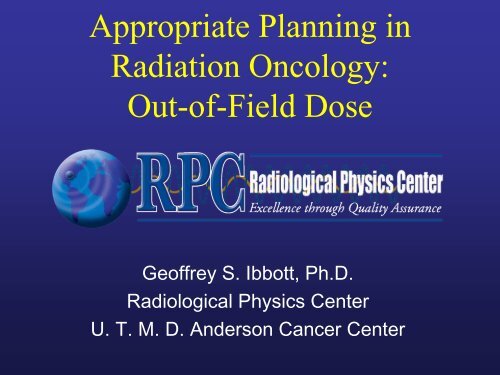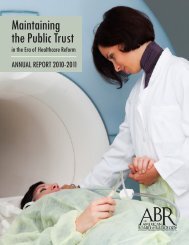Out of Field Dose Reduction by Geoffrey Ibbott, PhD
Out of Field Dose Reduction by Geoffrey Ibbott, PhD
Out of Field Dose Reduction by Geoffrey Ibbott, PhD
You also want an ePaper? Increase the reach of your titles
YUMPU automatically turns print PDFs into web optimized ePapers that Google loves.
Appropriate Planning inRadiation Oncology:<strong>Out</strong>-<strong>of</strong>-<strong>Field</strong> <strong>Dose</strong>Ge<strong>of</strong>frey S. <strong>Ibbott</strong>, Ph.D.Radiological Physics CenterU. T. M. D. Anderson Cancer Center
Much <strong>of</strong> this information from:<strong>Out</strong>-<strong>of</strong>-field Dosimetry for Secondary CancerStudies: Past Experience and Future Needs(1)Monte Carlo Organ <strong>Dose</strong> Calculations, Patient ModelsX. George Xu, Rensselaer Polytechnic Institute(2)MeasurementsDavid Followill, M.D. Anderson Cancer Center
Secondary Cancer Risk in Radiation Therapy:A Price to Pay for Aggressive RT?Hall and Wuu. Radiation-induced second cancers: The impact<strong>of</strong> 3D-CRT and IMRT.Int. J. Radiation Oncology Biol. Phys. Vol. 56, No. 1 pp 83-88.2003.• Cancer patients live longer• Patients are younger at diagnosis• Latent effects take time to appear• 3DCRT uses 18 MV (i.e, neutrons)• IMRT requires greater MUsbut generally 6 MV (no neutrons)• Advanced techniques (Tomotherapy,CyberKnife) use more/unusual beamangles• Proton therapy involves neutrons12
Neutrons• Neutrons produced <strong>by</strong> photons striking theprimary collimator, jaws, and target.• Neutrons are important because <strong>of</strong> theirhigh (uncertain) RBE.Radiation Type Energy Quality FactorX and gamma Rays All 1Neutrons< 10 keV 510 keV to 100 keV 10100 keV to 2 MeV 202 MeV to 20 MeV 10> 20 MeV 5
Calculations <strong>of</strong> Risk withEarly IMRT TechniquesLikelihood <strong>of</strong> Secondary Fatal Malignancy (%)Technique 6 MV 18 MV 25 MVConventional 0.3 1.8 3MLCmodulat ed1.0 5.1 8.4SerialTomotherapy2.7 14.9 24.4Calculated risk estimatesFollowill et al (1997)
Radiological Procedures and Estimates <strong>of</strong> Risk
<strong>Dose</strong> Levels in RT Patients (3D CRT vs. IMRT)7
2005 National Cancer Institute Guidelines for the Use <strong>of</strong>Intensity-Modulated Radiation Therapy in Clinical Trials
Two Ways to Determine Absorbed <strong>Dose</strong>Measurements• Phantom (Rando, Atom, etc)• Dosimeters (TLD, MOSFET, etc)Monte Carlo Simulations• Accelerator• Human anatomical model• Monte Carlo code
The History <strong>of</strong> Computational Phantoms- Simple to complex- Homogeneous to heterogeneous- Rigid to deformable- Stationary to moving- “Reference Man” to “reference library” or “person-specific” (?)ICRU sphere1960sMIRD anthropomorphicmodels in 1980sImage-based rigid,3D model in 1990-2000sNear FutureDeformable andmoving 4D models2008-2010Future?
3D VIP-Man Model fromthe Visible Human Project dataXu et al. VIP-Man: An image-based whole-body adult male model constructed from color photographs <strong>of</strong> the Visible Human Projefor multi-particle Monte Carlo calculations. Health Physics, 78(5):476-486, 2000.Original VHP Color PhotoSegmented Slice• 40-y old male, 186cm tall• Extremely small voxel, 0.33 x 0.33 x 1 mm 3• 80 organs segmented• Coupled with MCNP/X, EGS, GEANT4 codes3D VIP-Man
Results: Application for 3D-CRT and IMRTProstate Treatments (Rando Phantom)Energy(MeV)Gantryposition ( o )<strong>Field</strong> size(cm 2 )PrescribedMU4-field 3D-CRT 18 0 7 x 9.54 31590 7 x 7.96 315180 7 x 9.96 315270 7 x 7.64 3156-field 3D-CRT 18 45 7 x 10.46 21890 7 x 7.96 218135 7 x 9.96 218225 7 x 10.46 218270 7 x 7.64 218315 10 x 10 2187-field IMRT 6 0 8 x 10 23151 8.5 x 10 565102 8.5 x 9 446154 8.5 x 10.5 403206 8.5 x 10 387257 8.5 x 9.5 401308 8 x 10 41712
Comparison <strong>of</strong> Calculated and Measured <strong>Dose</strong>s18 MV 4-field 3D-CRT18 MV 6-field 3D-CRT6 MV 7-field IMRTMeasurement data taken from Wang et al.(2007)13
Application <strong>of</strong> the Framework for 3D-CRT and IMRTProstate Treatments (RPI Adult-Male)Organs Considered**StomachColonLiverLungEsophagusPancreasBrainActive Bone MarrowSmall IntestineSpleenGall bladderHeartLymph NodesKidneysThyroid**Important organs identified <strong>by</strong> ICRP publication 103that receive intermediate- and low-level doses14
Results: Total (Photon + Neutron) Organ <strong>Dose</strong>s to RPI-Adult Male from Prostate TreatmentsOrganTotal equivalent dose (μSv/MU)4-field 3D-CRT 6-field 3D-CRT 7-field IMRTStomach 8.36 (2.5%) 8.91 (2.0%) 8.90 (1.7%)Colon 23.91 (2.4) 27.21 (9.0) 27.63 (1.0)Liver 9.35 (1.8) 10.13 (1.4) 8.38 (1.1)Lung 7.24 (2.4) 7.56 (1.9) 3.85 (1.1)Esophagus 3.59 (16.9) 4.74 (12.4) 2.20 (5.8)Pancreas 7.59 (5.9) 8.79 (5.2) 6.84 (2.9)Brain 3.72 (4.2) 4.19 (9.3) 1.21 (3.4)Active bone marrow 7.65 (2.5) 7.42 (2.4) 6.91 (0.6)Small intestine 48.64 (0.7) 58.63 (0.5) 103.90 (0.4)Spleen 9.15 (6.1) 10.12 (4.1) 7.17 (2.8)Gall bladder 7.17 (5.5) 7.60 (5.1) 8.05 (2.5)Heart 6.08 (3.3) 5.85 (2.6) 3.86 (1.9)Lymph node 21.45 (6.2) 43.84 (2.7) 59.29 (1.1)Kidneys 12.41 (3.7) 15.41 (2.8) 14.09 (1.4)Thyroid 7.00 (20.6) 8.40 (17.5) 1.78 (10.4)First time detailedcomputational phantoms wereused to study intermediateandlow-level organ dosesfrom IMRT and 3D-CRTtreatments15
Neutron and Photon Organ <strong>Dose</strong> Dependson Angle and Energyback front view view16
Monte-Carlo Calculations: Summary• Realistic computational phantoms available• A MC-based accelerator and patientcomputational framework available• Energy fluence (photon and neutron) dataAccurate “non-target” dosimetry data reported• Need a library <strong>of</strong> treatment modality models• Need easy-to-use s<strong>of</strong>tware tools for reportingnon-target dose
Measurement Techniques• Solid or liquid geometric phantoms– Cylindrical small-volume ion chambersKlein et al. (2006)
Most Recent Measurements• Anthropomorphic Rando phantom with TLDat 10 specific organ sites.• 3 TLDs at each location.Kry et al (2005)
Adult Procedure• Adult Prostate Treatment withTomoTherapy and CyberKnife– Same prescribed dose– Common TLD placement
Pediatric Procedures• Pediatric Cranio-Spinal and GBM treatments– Same prescription for• 3D, Tomotherapy, proton treatment plans (CSI)• IMRT and CyberKnife treatment plans (GBM)– TLD and EBT film placement in pediatric phantom– Organ doses from TLD-100– EBT film validation <strong>of</strong> TPS calculations
Photon Measurement Cautions• Low doses = very low rdgs.• Uncertainty <strong>of</strong> measurements• Long exposure times• Need for multiple rdgs. at each point• Location (air vs. phantom) and depth• Point vs. volume measurements• Neutron component for high X-ray energies
Neutron Measurements• Neutron fluence measured with gold foils.– 197 Au(n,γ) 198 Au• Count the γ,β emissions <strong>of</strong> the foils, convert toneutron fluence <strong>by</strong> NIST traceable conversion factor:• Gold foils detect thermal neutrons.– Bare gold foils to measure thermal neutron fluence.– Fast neutrons are thermalized <strong>by</strong> moderators. Gold foils inmoderators measure the fast neutron fluence.
Neutron Measurements• Bonner sphere system to measure thefluence from which the neutronspectrum is deconvolved.Howell et al (2006)
Neutron Measurement Cautions• Gold foil activation – not for everyone.• NIST traceability• Still the “gold” standard• Low doses = very low rdgs.• Increase in uncertainty <strong>of</strong> measurements• Long exposure times• Need for multiple rdgs. along patient plane.• Measurement variability among the differentneutron dosimeters• Difficulty measuring the neutron dose at depth ina patient
<strong>Dose</strong> Equivalent per CompleteProstate Treatment(photon and neutron)<strong>Dose</strong> Equivalent (cSv) per complete Adult Prostate Treatment18 MV 6 MV 6 MV 6 MV 18 MVOrgan Site 3D CRT IMRT TomoTherapy CyberKnife IMRTThyroid 12.7 5.3 2.4 34.4 15.3 54.6Lung center 12.6 6.7 5.1 27.0 12.0 44.7Esophagus center 9.6 6.2 4.2 25.4 11.3 35.1Liver center 24.2 15.5 12.2 27.7 12.3 69.3Stomach center 23.2 19.9 15.6 30.3 13.4 68.7Trans. Colon 48.2 33.3 27.6 19.042.8 - 42.8 101.4Treatment Plan. Sys. Pinnacle Pinnacle HiArt plan station Multiplan CorvusData from Kry et al, S. Lazar, M. Bellon
Risk (%) <strong>of</strong> Secondary Cancer perComplete Prostate Treatment(photon and neutron)Lifetime Risk (%) <strong>of</strong> Secondary Cancer per Prostate Treatment18 MV 6 MV 6 MV 6 MV 18 MVOrgan Site 3D CRT IMRT TomoTherapy CyberKnife IMRTThyroid 0.00 0.00 0.00 0.00 0.00Lung center 0.12 0.06 0.05 0.25 0.11 0.42Esophagus center 0.06 0.04 0.02 0.07 0.15 0.20Liver center 0.03 0.02 0.01 0.03 0.01 0.08Stomach center 0.03 0.02 0.02 0.01 0.03 0.08Trans. Colon 0.24 0.16 0.14 0.090.21 - 0.21 0.50Treatment Plan. Sys. Pinnacle Pinnacle HiArt plan station Multiplan CorvusData from Kry et al, S. Lazar, M. Bellon
<strong>Dose</strong> Equivalent to Stomach<strong>Dose</strong> Equivalent to Center <strong>of</strong> Stomach1000900800Neutron <strong>Dose</strong> EquivalentPhoton <strong>Dose</strong> Equivalent700<strong>Dose</strong> Equivalent (mSv)600500400300200100018 MV CRTPinnacle6MV VCorvus6MV VPinnacle6MV SCorvus10MV VCorvus15MV VCorvus15MV SCorvus18MV VCorvus6MV TomoPlan. Sta.6MV CKMultiplanTreatment Approach
<strong>Dose</strong> Equivalent and Risk (%) perComplete Pediatric GBM Treatment<strong>Dose</strong> Lifetime Equivalent Risk (%)(cSv)per complete Pediatric GBM Treatment6 MV 6 MV CyberKnifeOrgan Site IMRT version 1.5 version 2.1Thyroid 0.04 5.5 32.2 0.24 19.3 0.15Lung center 0.10 3.7 60.2 1.59 39.1 1.03Breast 0.05 2.5 12.3 0.26 0.17 8.0Liver center 0.01 1.5 0.03 9.2 0.02 6.0Stomach Trans. Colon center 0.02 1.1 0.12 8.5 0.08 5.5Ovary 0.00 1.0 0.04 8.1 0.02 5.3Treatment Plan. Sys. Pinnacle Multiplan MultiplanNew optimization and tuning tools, more experienced planner
• 5 proton centers inoperation• At least 5 moreunder constructionProton Treatments
How significant can this be?Stray Radiation Exposure from Different RT FacilitiesH/D (mSv/Gy)1000.00100.0010.001.000.100.010.000 50 100 150Distance from <strong>Field</strong> Edge (cm)Hall, Harvard, Passive,Normalized to 10x10 cm2Yan, Harvard, Passive, 8 cmSOBP, FS=5x5 cm2Zheng, PTCH, Passive, 8 cmSOBP, FS=10x10 cm2Hall, 4 <strong>Field</strong> CRT, 6 MVZheng, PTCH, Passive, PristinepeakHall, IMRT, 6 MVSchneider, PSI, Scanning,Pristine peakMesolaras, MRPI, PassivePolf, Harvard, Passive, Large<strong>Field</strong>, 8 cm SOBPTayama, PMRC, Passive, 10 cmSOBP, FS=11 cm2Fontenot, Harvard, Radiosurgery,pristine peakYan, Harvard, Passive,RadiosurgeryYan, Harvard, Ocular, 2.3 cmSOBPSlide Hall courtesy (2006) <strong>of</strong> J Fontenot
Experimental SetupHeadHip23.5 cm23 cmShoulder
Comparison <strong>of</strong> the doses in the pediatric CranioSpinal casetreated <strong>by</strong> 3D-conventional, tomotherapy, and proton therapyOrgan site3D 6 MV(cGy)TomoTherapy(cGy)Proton(120-180 MeV)(cSv)Thyroid 2797 (12) 362 (12) 22Lt. Breast Bud 152 (9) 437 (6)Heart center 2957 (41) 865 (16) 21.8Heart edge 2345 (18) 438 (16)Lt. Lung center 226 (13) 907 (43)Lt. Lung Edge 242 (33) 446 (9)Liver Center 2583 (18) 1107 (124)Liver edge 217 (14) 545 (16)Lt. Kidney 221 (6) 748 (83)Bladder 195 (11) 77 (2) 17.7Pelvic 86 (4) 528 (30)Lt. Ovary 322 (60) 135 (22)Data from S. Lazar and Z. Wang, MDACC
Summary• No consensus as to the best measurement technique.Calculations will play a larger role in the future.• Increases in the secondary dose are highly dependent onthe number <strong>of</strong> MUs and photon energy.• Measurement <strong>of</strong> the secondary dose requires anestablished NIST traceable technique and characterization<strong>of</strong> the dosimeters at the appropriate energies.• New treatment planning s<strong>of</strong>tware with better optimizationroutines have reduced the number <strong>of</strong> MUs per treatmentreducing the secondary doses.• Neutron dose may play less <strong>of</strong> a role than previouslythought.
Take Home Message• Biggest uncertainty is the RISK estimate• There are many factors to be considered inthe treatment <strong>of</strong> a patient and the risk <strong>of</strong> asecondary cancer is only one <strong>of</strong> many.• Overall risk is small• Risk can be reduced <strong>by</strong> attention to treatmentmodality, delivery method, planning technique
Additional References• National Cancer Institute “Guidelines for the Use <strong>of</strong> Intensity-ModulatedRadiation Therapy in Clinical Trials” since 2005• AAPM Symposium on “Secondary Cancer Risk for Emerging RadiationTreatments” 2006, 2008• ICRP/ICRU TG on “Risk <strong>of</strong> second cancers” since 2006• NCRP SC 1-17 on “Second Cancers and Cardiopulmonary Effects AfterRadiotherapy” since 2007• AAPM TG-158 “Measurements and calculations <strong>of</strong> doses outside thetreatment volume from external beam radiation therapy” since 2007• Xu, Bednarz, Paganetti in PMB, “A review <strong>of</strong> dosimetry studies on externalbeamradiation treatment with respect to second cancer induction” 200836
















